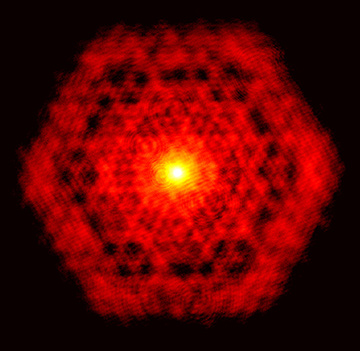 An experimental fractal mode from a laser. [Enlarge figure]
An experimental fractal mode from a laser. [Enlarge figure]
Fractals—complex shapes seen every day in nature—feature a distinctive, repeating geometry. They occur in diverse forms, from Romanesco broccoli to ferns, and even at larger scales in settings such as salt flats, mountains, coastlines and clouds. An unstable laser cavity is almost the precise opposite of nature, so a prediction 20 years ago that light beams emitted from such lasers could be fractals came as a surprise.1 Recently, a team from South Africa and Scotland provided the first experimental evidence for fractal light from simple lasers, and added a new prediction: that the fractal light should exist not just in 2-D, but in 3-D.2,3
Fractals imply a “pattern within a pattern,” so that the structure appears to repeat at different scales with different magnification. Nature creates fractals—for example, to produce a snowflake—through multiple recursions of a simple rule. Computer programs have been used to do the same by looping through such rules over and over, famously producing the Mandelbrot and Serpinski triangle patterns.
The light inside a simple laser also does this, cycling back and forth and bouncing between the mirrors on each pass. The mirrors can be set to image the light into itself on each round trip at a common imaging plane. The light can be considered to begin at this plane, travel across the laser cavity to bounce off the rear mirror, travel to the other mirror to bounce off again, and then return to the starting plane. At this common imaging plane, the retuning light is a magnified or demagnified version of the initial light.
In the case where the returning light is smaller by a factor M, after one trip it will be smaller by M, after two trips by M2, after three by M3 and so on—just as in a recursive loop. Thus each time the light returns to the image plane, it is a smaller (or bigger) version of what it was: a pattern within a pattern within a pattern—the definition of a fractal. What had not previously been fully appreciated is that this magnification (or demagnification) happens inside the laser cavity at a particular plane, so to see the fractal one needs to look “inside the box,” and not at what comes “out of the box.” We don’t usually look inside lasers; thus the experimental verification remained elusive for two decades until the work reported this year.
In developing the theory to understand where to look, the team behind the 2019 work also made a new prediction: 3-D fractals, in which the fractal nature occurs both along the laser axis and in the transverse plane. To see this structure would require a careful scan of the laser’s interior in 3-D around the common imaging plane. This remains an exciting and open challenge.
Fractals have found applications in imaging, networks, antennas and even medicine. Now these exotic states of structured light can easily be created from a laser, further enhancing their usefulness.
Researchers
Andrew Forbes, Hend Sroor and Darryl Naidoo, University of the Witwatersrand, South Africa
Steven Miller, John Nelson and Johannes Courtial, University of Glasgow, U.K.
References
1. G.P. Karman et al. Nature 402, 138 (1999).
2. H. Sroor et al. Phys. Rev. A 99, 013848 (2019).
3. O. Graydon. Nat. Photon. 13, 228 (2019).

